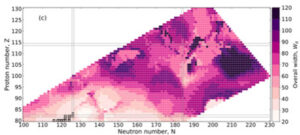They assumed that the nuclear shape evolution is strongly damped which gives the fission process the character of Brownian motion that can be simulated as a random walk on the multi-dimensional deformation-energy surface of the fissioning system. These surfaces have been (previously) calculated by augmenting the macroscopic (liquid-drop like) deformation energy with the shell and pairing effects associated with each specific shape. (Fig. 1.)

Figure 2. This chart shows the overall width of the mass yield, defined as the number of fragment mass numbers A for which the (normalized) yield Y(A) exceeds 1% [1].
Using their recently developed method, Randrup and collaborators calculated a comprehensive set of fission-fragment yields from over 3,800 nuclides bounded by 80 ≤ Z ≤ 130 and A ≤ 330; these yields have been made available to the community as ASCII files. The resulting yields compare well with the experimental data (where available). Generally, the fragment mass yields tend to be rather wide in the r-process region, a feature with important implications for the fission recycling process (Fig. 2).
Reference
M.R. Mumpower, P. Jaffke, M.Verriere and J. Randrup, arXiv:1911.06344.
